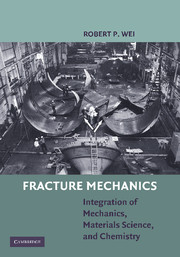Book contents
- Frontmatter
- Contents
- Preface
- Acknowledgments
- 1 Introduction
- 2 Physical Basis of Fracture Mechanics
- 3 Stress Analysis of Cracks
- 4 Experimental Determination of Fracture Toughness
- 5 Fracture Considerations for Design (Safety)
- 6 Subcritical Crack Growth: Creep-Controlled Crack Growth
- 7 Subcritical Crack Growth: Stress Corrosion Cracking and Fatigue Crack Growth (Phenomenology)
- 8 Subcritical Crack Growth: Environmentally Enhanced Crack Growth under Sustained Loads (or Stress Corrosion Cracking)
- 9 Subcritical Crack Growth: Environmentally Assisted Fatigue Crack Growth (or Corrosion Fatigue)
- 10 Science-Based Probability Modeling and Life Cycle Engineering and Management
- APPENDIX: Publications by R. P. Wei and Colleagues
- References
6 - Subcritical Crack Growth: Creep-Controlled Crack Growth
Published online by Cambridge University Press: 05 June 2012
- Frontmatter
- Contents
- Preface
- Acknowledgments
- 1 Introduction
- 2 Physical Basis of Fracture Mechanics
- 3 Stress Analysis of Cracks
- 4 Experimental Determination of Fracture Toughness
- 5 Fracture Considerations for Design (Safety)
- 6 Subcritical Crack Growth: Creep-Controlled Crack Growth
- 7 Subcritical Crack Growth: Stress Corrosion Cracking and Fatigue Crack Growth (Phenomenology)
- 8 Subcritical Crack Growth: Environmentally Enhanced Crack Growth under Sustained Loads (or Stress Corrosion Cracking)
- 9 Subcritical Crack Growth: Environmentally Assisted Fatigue Crack Growth (or Corrosion Fatigue)
- 10 Science-Based Probability Modeling and Life Cycle Engineering and Management
- APPENDIX: Publications by R. P. Wei and Colleagues
- References
Summary
Overview
In the foregoing chapters (2 through 5), the essential framework for linear elastic fracture mechanics is introduced. Within this framework, the presence (or pre-existence) of a crack, or crack-like damage is assumed, and the driving force for its growth is given by an appropriate stress intensity factor (KI), or strain energy release rate (GI), that reflects the size, shape, and location of the damage relative to the loading. These chapters address, however, only the first of the “customer's questions” raised in Chapter 1; namely, “How much load will it carry?” They serve only as a basis for the design and management of engineered systems to guard against catastrophic failure.
Customer's Questions
How much load will it carry, with or without cracks? (structural integrity and safety)
How long will it last, with and without cracks? (durability)
Are you sure? (reliability)
How sure? (confidence level)
At loadings that are below that required for fracture, the next question is whether the damage can grow through time-dependent (subcritical crack growth) processes that lead to the progressive loss of design strength and reliability, and increase the chances for failure. The modes of subcritical crack growth in inert and deleterious environments are shown in Table 6.1. Subcritical crack growth under statically applied loads in deleterious environments (stress corrosion cracking), and fatigue crack growth under cyclically applied loads (in benign and deleterious environments), or fatigue and corrosion fatigue, were and are readily accepted.
- Type
- Chapter
- Information
- Fracture MechanicsIntegration of Mechanics, Materials Science and Chemistry, pp. 86 - 102Publisher: Cambridge University PressPrint publication year: 2010



